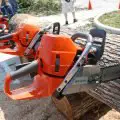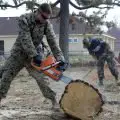You are prepared to gather timber from the downed trees on your property or another location. The situation is under control. You may eventually feel the chainsaw heating up. You nonetheless carry on.
The chainsaw stops after cutting a few pieces of wood effectively. You try everything, but the heated chainsaw won’t switch on despite your best efforts. Why?
You either have an issue with the spark or with the gas flow being blocked into the engine if your chainsaw stops working once it gets hot. This frequently happens to older chainsaw models. Spark plug replacement and maintaining clean gas lines help lower the likelihood of this issue repeating.
In this article, we’ll discuss the reasons why your chainsaw won’t start when hot, along with fixes to each, and cooling techniques to keep in mind.
Table of Contents
- Reasons Why Your Chainsaw Won’t Start When Hot
- Chainsaw Preventative Tips and Cooling Techniques
- FAQs (Frequently Asked Questions)

Reasons Why Your Chainsaw Won’t Start When Hot
- Restricted fuel supply
- Vapor lock
- Ignition problems
- Worn-out carburetor
Restricted Fuel Supply
Frequently, a warm engine inhibits the fuel flow to the carburetor. Now, the cause of this might either be a filthy fuel filter or faulty fuel lines. On the end of your main hose, a dirty fuel filter may cause this to happen.
How to Fix a Restricted Fuel Supply?
If so, the remedy is comparatively simple. If you are unable to remove the dirt from a dirty fuel filter, it needs to be replaced right away. Replace any damaged gasoline lines with new ones, and you will be ready for the season.
Vapor Lock
When the vents are not working properly, extra heat or vapors can build up in the fuel tank, which is referred to as a “vapor lock.” This in turn prevents the carburetor from receiving fuel. Therefore, only look for a vapor lock once you are certain that the fuel filter or the fuel lines are flawless.
Remove the gasoline fuel cap and let the gases exhaust to see if you have a vapor lock or not. Your saw restarting after this step demonstrates that you experienced a vapor lock.
How to Fix Vapor Lock?
The solution to vapor lock is rather straightforward. Verify the gasoline tank’s vent hole. Gently clean out the accumulated debris. For a smooth vapor exit, you should also frequently clean the tank vents.
Ignition Problems
The spark plug should be checked after confirming that the gasoline filters, fuel lines, and tank vents are all functioning properly. This is due to the fact that when the chainsaw gets hot, a spark plug that is corroded or covered with dirt won’t ignite. This ignition issue suggests that the ignition module or the coil inside the module may have some problems.
How to Fix Ignition Problems?
Start the saw to address this issue. The saw will stop as soon as it heats up. The open choke valve, which is visible under the air filter, should now be filled with starting fluid. Understand that there is a fuel system issue if the saw starts up smoothly. If not, you must either swap either the coil or the ignition module.
Worn-Out Carburetor
Carburetor wear is simple to spot. Open the choke hole and inject some carburetor cleaner before starting the engine. Dark and heavy smoke coming from the carburetor indicates that it needs to be cleaned right away.
In addition, a carburetor with white, gooey deposits would prevent fuel from reaching the engine. The saw would not start as a result.
How to Fix a Worn-Out Carburetor Problem?
Your carburetor needs to be cleaned and maintained. To improve the flow of fuel via older carburetors, try installing a carburetor repair kit. Similar issues can also be brought on by a failed fuel pump inside the carburetor or by diaphragm warping.
Just after starting the engine, squirt some carb cleaner into the open choke hole to check for a filthy carburetor. Your carburetor is unclean if you see a lot of thick, black smoke coming from the exhaust system.
Additional chainsaw won’t start related pages:
- How to Unflood a Chainsaw and Start It Once Flooded [GUIDE]
- Chainsaw Won’t Start – Problem Solved! Ask for Support
- Husqvarna Chainsaw Won’t Start? Here’s How to Get a Husqvarna Chainsaw to Start
Chainsaw Preventative Tips and Cooling Techniques
Due to some gas additives presently, fuel tanks can frequently become vapor trapped. Always inspect the tank’s vents to ensure that no debris has accumulated there. Tank vents stop the development of vapor locks.
Verify the cleanliness and debris-free operation of the carburetor’s jets. Avoid operating your engine at a lean fuel setting because doing so might cause some engine parts to overheat and become prone to failure. This includes different gaskets and seals, which are extremely likely to sustain damage from exposure to high temperatures.
Additionally, this is crucial to avoiding piston failure. The chainsaw won’t start when hot because some spark plugs won’t ignite when they are too hot.
By employing the following chainsaw cooling measures, you can help prevent a chainsaw from getting hot:
- Always make sure the gas tank has enough fuel mixture by checking it frequently.
- Never put fresh fuel into a hot engine when refueling.
- When not in use, never keep your battery chainsaw out in the open or near a window.
- Regularly tighten the saw’s nuts and bolts that go loose with use.
- After using the chainsaw, check for any debris and clean it if necessary. then keep it in storage
- Your chainsaw’s blades should occasionally be sharpened with an electric file.
Visit our Chainsaw Bar Upkeep and Maintenance guide for more tips on looking after your chainsaw!
FAQs (Frequently Asked Questions)
What happens when a chainsaw gets too hot?
The friction caused by metal-to-metal contact increases significantly when a chainsaw gets too hot because the oil in the guide bar runs out. The guide bar and chain soon overheat as a result and it’s very likely that it will harm your chainsaw or maybe spark a fire if the situation doesn’t improve.
Why won’t my chainsaw start after running?
The internal combustion engine of a chainsaw is started by the carburetor, which mixes fuel and air. Long-term storage of fuel can cause it to thicken and clog the carburetor, making it difficult to start the engine. Clean the carburetor if the obstruction is only small otherwise, you made need a replacement.




